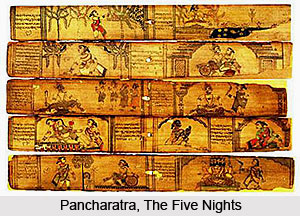 The tradition associated with the worship of Narayana is the Pancharatra. The name `pancharatra` (`five-night`) may well be derived from the `five night sacrifice` mentioned in the Satapatha Brahmana in which Purusa-Narayana conceives the idea of a sacrifice lasting five nights whereby he would become the highest being. The doctrines of the Pancharatra are mentioned in the Narayaniya section of the Mahabharata. Here Bhagavan Narayana, who pervades the universe and is seen in all religious systems, is regarded as the preceptor of the Pancharatra tradition. Yet although Narayana denotes their supreme deity, the term Vasudeva is also used.
The tradition associated with the worship of Narayana is the Pancharatra. The name `pancharatra` (`five-night`) may well be derived from the `five night sacrifice` mentioned in the Satapatha Brahmana in which Purusa-Narayana conceives the idea of a sacrifice lasting five nights whereby he would become the highest being. The doctrines of the Pancharatra are mentioned in the Narayaniya section of the Mahabharata. Here Bhagavan Narayana, who pervades the universe and is seen in all religious systems, is regarded as the preceptor of the Pancharatra tradition. Yet although Narayana denotes their supreme deity, the term Vasudeva is also used.
Indeed, the Paricaratra is characterized by a doctrine of the manifestation of the absolute through a series of emanations or vyuhas. These begin with Vasuveda who manifests Samkarsana, who in turn manifests Pradyumna, from whom Aniruddha emerges. These are the names of Lord Krishna`s elder brother, his son, and grandson, respectively, though the familial relation is not particularly significant in the cosmology of the system. This series of vyuha emanations comprise the highest level of the universe, the `pure creation`, while below this are intermediate or `mixed` creation and the `impure` or `material` creation, Each vyuha has a cosmological function with regard to the lower creation, which manifests through Pradyumna. The cosmos below the vyuhas is made up of categories (tattva) some of which have their origin in the earlier philosophical system of Samkhya.
Apart from the Narayaniya section of the Mahabharata, which bears witness to the early existence of the tradition, Pancharatra literature as a distinct genre develops only from about the seventh or eighth centuries CE. This literature, known as the Pancharatra Samhitas, is classified as part of a wider group of texts known as Agamas or Tantras texts which were rejected by many orthodox Brahmans. The most important of these texts are the three gems of the Pauskara, Sattvata and Jakakhya Samhitas, and the Ahirbudhnya Samhita and Laksmi Tantra should also be mentioned as important texts within the tradition. The essence of Pancharatra is to submit the soul to god. There are six aspects that are Atma-nikshepa or nyasa, karpanya, maha-visvasa, goptr, pratikulya-vivarjana, Anukulya-niscaya. The concerns of this literature are cosmology, initiation (diksa), ritual, sacred formulae (mantra) and temple building. The texts form the basis of worship in south Indian temples to this day, with Vedic mantras replacing tantric mantras and Vedic deities replacing tantric deities.
The Pancharatra Samhitas represent `tantric` Vaishnavism in contrast to an `orthodox` Vedic Vaishnavism of the Bhagavatas. Moreover, many orthodox Brahman accepted the authority of the Veda, rejected the authority of the Tantras. Indeed, the status of the Pancharatra Samhitas within Vaishnavism, whether or not they could be classed as revelation, was an issue which provoked debate, with Yamuna, one of the teachers of the Sri Vaishnava tradition, arguing for the status of these texts as revelation. One tradition of Brahmans who are associated with the Pancharatra, but who remain distinct from them over this issue of orthodoxy, is the Vaikhanasas.




















